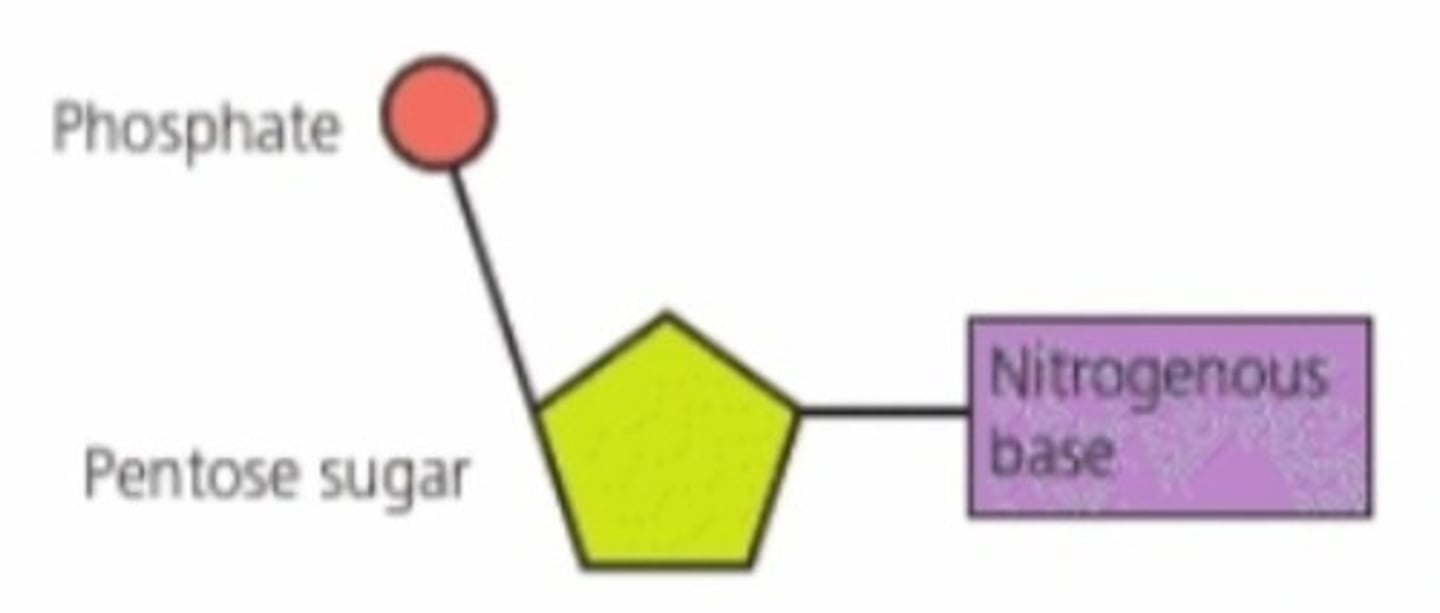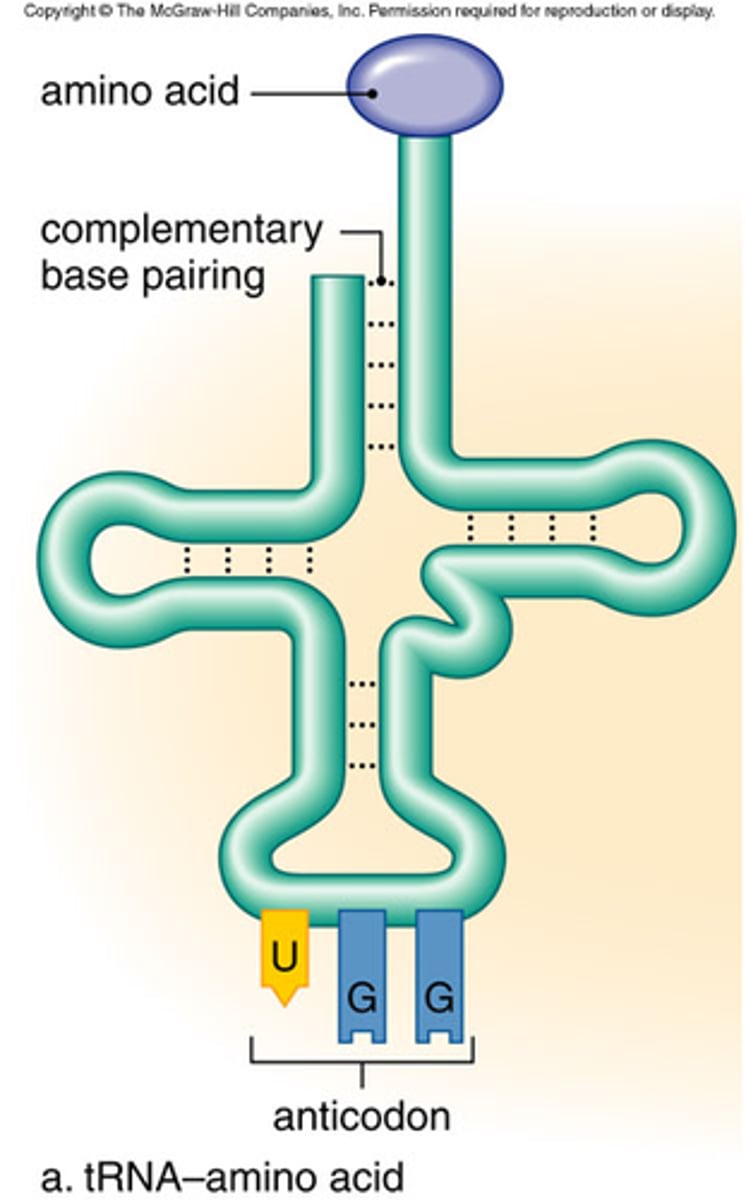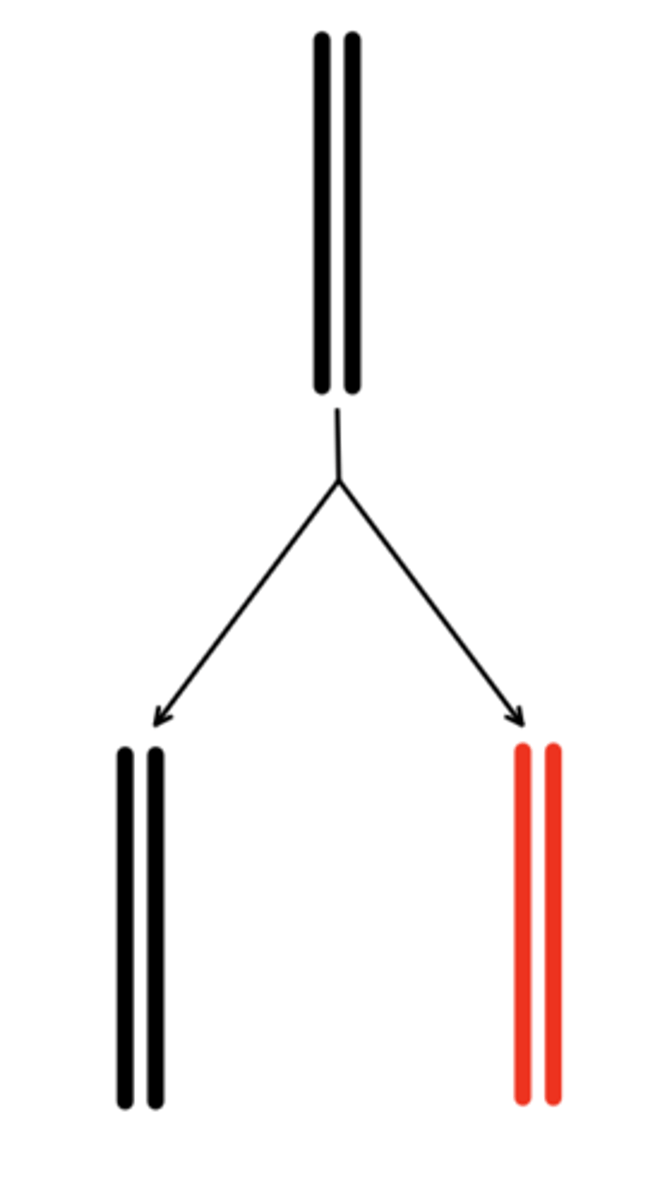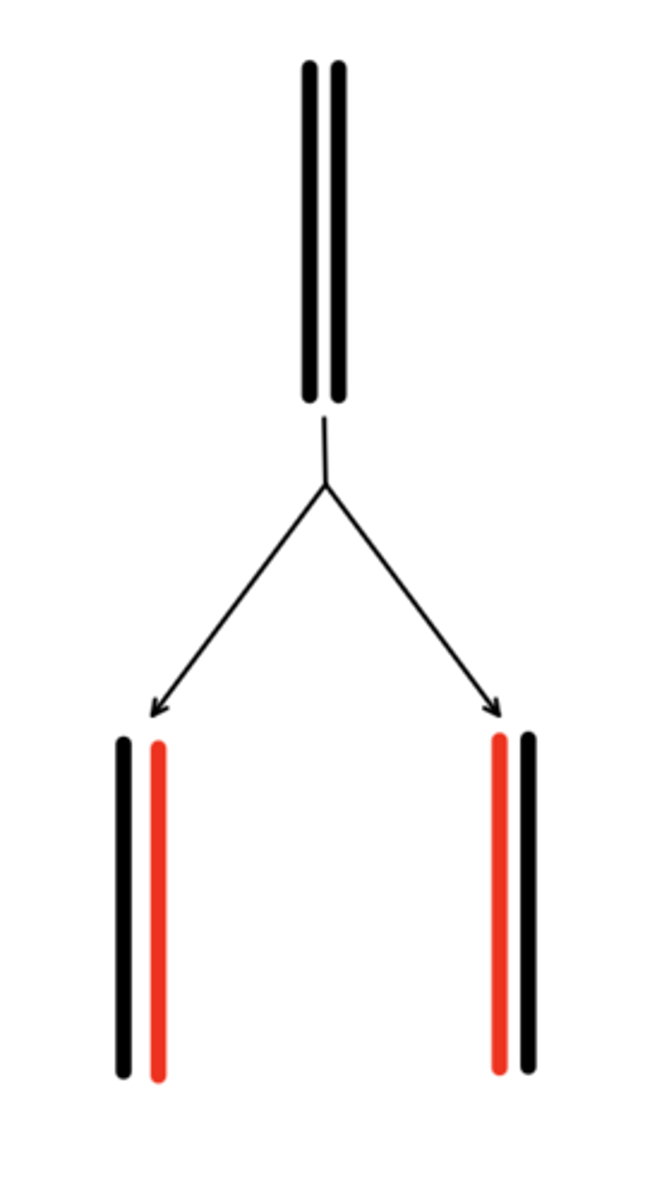Eduqas Biology A Level Core Concepts - Nucleic Acids and their functions (includes ATP)
1/103
There's no tags or description
Looks like no tags are added yet.
Name | Mastery | Learn | Test | Matching | Spaced |
|---|
No study sessions yet.
104 Terms
Nucleic acid definition
A polymer of nucleotides
What are DNA and RNA examples of?
nucleic acids
What does DNA stand for?
deoxyribonucleic acid
What does RNA stand for?
ribonucleic acid
What is ATP an example of?
A nucleotide
Why is ATP considered a nucleotide and not a nucleic acid?⁶
It is one singular molecule, whereas nucleic acids are polymers
What does ATP stand for?
adenosine triphosphate
Nucleotide definition
The basic unit (monomer) from which nucleic acids are formed
What are the 3 main components of a nucleotide?
phosphate group, sugar, and an organic nitrogenous base
Draw a simple nucleotide, showing the sections clearly with labels

What is special about the sugar in all nucleotides?
It is always a pentose (5 carbons)
What is the pentose sugar in DNA?
deoxyribose
What is the pentose sugar in RNA?
ribose
What is the pentose sugar in ATP?
Ribose
How many different nitrogenous bases are there?
5
What nitrogenous base does ATP contain?
Adenine
Why is ATP considered the universal energy currency?
Because it is used in all energy-requiring reactions in all cells in all living organisms
Draw an ATP molecule and label its parts.

What reactions is ATP used in?
- Active transport
- Protein synthesis
- Nerve transmission
- Muscle contraction
How is ATP formed?
By adding a phosphate group to ADP (phosphorylation of ADP)
What kind of reaction is the combination of ADP and a phosphate group?
condensation
What kind of reaction is the formation of ADP and a phosphate group from ATP?
hydrolysis
How much energy is realised by the hydrolysis of ATP?
30.6kJ
What are two groups of nitrogenous bases?
Pyrimidine and purine
What are the 5 kinds of nitrogenous bases?
Adenine, cytosine, guanine, thymine and uracil
How would you differentiate between a pyrimidine base and a purine base?
Pyrimidine bases are single ringed, purine bases are double ringed
What are the pyrimidine bases?
Cytosine, thymine, uracil
What are the purine bases?
Adenine and guanine
What bases does DNA contain?
Adenine, Thymine, Guanine, Cytosine
What bases does RNA contain?
Adenine, Guanine, Cytosine, Uracil
Describe the structure of DNA
DNA is made up of two strands of nucleotides wound into a double helix, with a sugar-phosphate backbone and inner facing bases
What forms the backbone of a DNA strand?
sugar and phosphate
What bonds form between the sugar and the phosphate group of adjacent nucleotides in a DNA molecule?
covalent
What holds the two strands of DNA together?
hydrogen bonding between complimentary base pairs
What kind of bond forms between complimentary base pairs in DNA?
hydrogen bonds
What base does the base adenine pair with in DNA?
Thymine
What base does the base thymine pair with in DNA?
Adenine
What base does the base cytosine pair with in DNA?
Guanine
What base does the base guanine pair with in DNA?
Cytosine
How many hydrogen bonds are between adenine and thymine?
2
How many hydrogen bonds are between cytosine and guanine
3
If 20% of the bases in DNA are adenine, what is the % of each of the other bases?
Thymine = 20%
Guanine = 30%
Cytosine = 30%
What are the 3 types of RNA?
Messenger RNA (mRNA)
Ribosomal RNA (rRNA)
Transfer RNA (tRNA)
What is the purpose of mRNA?
To carry genetic information from the DNA to the ribosomes for protein synthesis
What is the purpose of rRNA?
It combines with proteins to make ribosomes
What is the purpose of tRNA?
Transports amino acids to the ribosome for translation
Where is mRNA formed?
nucleus
Genetic code defintion
The way in which information about the sequence of amino acids in a protein is coded by the bases on a molecule of DNA
Describe the process of DNA replication
- A DNA molecule is unwound and the hydrogen bond between complimentary base pairs are broken by the enzyme DNA helicase
- Each separated single strand of DNA now acts as a template, and free DNA nucleotides will line up against complimentary base pairs on the template strand
- DNA polymerase catalyses the combination of adjacent free DNA nucleotides, creating a new chain
- A new DNA molecule has been formed, made from one parent strand and one newly synthesised chain
What is DNA helicase and what does it do?
An enzyme that unwinds and unzips the double helix
What is DNA polymerase and what does it do?
DNA polymerase is an enzyme that joins individual nucleotides to produce a new strand of DNA
What is the structure of mRNA?
Single, uncoiled strand
What is the structure of rRNA?
globular
What is the structure of tRNA?
cloverleaf shaped, with one arm carrying the anticodon

What are the two functions of DNA?
replication and protein synthesis
What are the names of the 3 theories of DNA replication?
conservative replication, semi-conservative replication and dispersive replication
Draw a diagram to show conservative replication of DNA

Draw a diagram to show semi-conservative replication of DNA

Draw a diagram to show dispersive replication of DNA

What is conservative replication of DNA?
The parental DNA molecule remains intact, and a completely new DNA molecule is synthesised
What is semi-conservative replication of DNA?
The parental double helix splits, each acting as a template for two new strands. Both new DNA molecules contain 1 parent strand and 1 newly synthesised strand
What is dispersive replication of DNA?
The two new double helices contain fragments from both strands of the parental DNA strand, as well as newly synthesised fragements
Describe the Meselson-Stahl experiment
- They grew bacterium with the heavy isotope of nitrogen, so the isotope was incorporated into the DNA (centrifuged sample produces a low band)
- The bacteria is then placed in the light isotope of nitrogen and allowed to replicate once (produces a band in the middle)
- In the same isotope, the bacteria are allowed to replicate again (produces one band in the middle and one band at the bottom)
What theory of DNA replication does the Meselson-Stahl experiment support?
semi-conservative
Define gene
A section of DNA on a chromosome which codes for a specific polypeptide
What is a codon?
A three-nucleotide sequence that codes for an amino acid
Why is the genetic code described as degenerate?
More than one codon can represent one amino acid
Define genetic code
The DNA and mRNA base sequences that determine the amino acid sequences in an organism's proteins
What is a stop codon?
A codon that signals the end of translation
Define Exon
coding regions of DNA and RNA (included in mRNA)
Define Intron
non-coding sequences of DNA and pre-mRNA (not included in mRNA)
What is removed and what is kept when pre-mRNA is changed into mRNA?
Introns are removed, Exons are kept
Define transcription
The process of copying the genetic code from DNA into the form of mRNA
Define translation
Assembling a protein using the message carried by mRNA
Describe the process of transcription
- DNA unwinds and separates using DNA Helicase, making two separate template strands
- Free RNA nucleotides align with template strand through complimentary base pairing
- RNA polymerase bonds the nucleotides together, forming a molecule of mRNA complimentary to the DNA
- mRNA leaves nucleus via nuclear pores
Describe the process of translation
- mRNA attaches to the ribosome and translation begins with the start codon
- A tRNA molecule with an anti-codon complimentary to the start codon lines up against the mRNA strand
- A second tRNA molecule lines up adjacent to the first
- The adjacent amino acids on each tRNA molecules form peptide bonds with the aid of an enzyme
- The first tRNA molecule detaches and new tRNA molecule joins, lengthening the polypeptide chain
- This carries on until a stop codon is reached
- The both the mRNA molecule and the newly synthesised polypeptide chain leave the ribosome
The conversion of ATP into ADP is a _______ reaction and ______ energy
hydrolysis, releases
The conversion of ADP into ATP is a _______ reaction and ______ energy
condensation, uses/requires
What makes ATP a better supplier of energy than glucose?
- For ATP, it is a single step reaction whereas for glucose there are many steps
- ATP gives out a manageable release of energy, unlike glucose with its sudden, explosive release
- Only one enzyme is required for ATP, but glucose requires more
- ATP is a smaller molecule so is easier to transport than glucose
In what nucleic acids is Uracil found?
RNA only
In what nucleic acids is Thymine found?
DNA only
DNA helicase is important in DNA replication. Explain why
- DNA helicase unwinds the DNA double helix and separates the two strands
- So that free DNA nucleotides can attach and a new strand can be made
Describe the role of DNA polymerase in DNA replication
It joins nucleotides together and forms the sugar-phosphate backbone
Other than being smaller, give two ways in which prokaryotic DNA is different from eukaryotic DNA
- It doesn't form chromosomes
- It is circular
- It contains no introns
When analysing the DNA of a virus, it was found that the percentages of each base are as follows:
Adenine = 24.0%
Guanine = 23.3%
Thymine = 21.5%
Cytosine = 31.2%
Suggest what this may indicate about viral DNA
- The complimentary base pairs do not share the same percentage (A does not equal T, G does not equal C)
- This tells us there is no base pairing involved
- Therefore the viral DNA is most likely single stranded
Which molecule is know as the 'universal energy carrier'?
ATP
Which components of a DNA molecules form its backbone?
Deoxyribose sugar and phosphate
groups
What is the mechanism of DNA replication known as?
semi-conservative replication
Why is semi-conservative replication called what it is?
Each new DNA molecule produced contains one original parental strand and one newly synthesised strand
Name the bond formed between the bases on a DNA helix
hydrogen bond
Explain what is meant by the term 'triplet code'
A sequence of 3 bases to form an amino acid
What is the difference between an intron and an exon?
- Introns are a non-coding nucleotide
sequence in DNA that is removed before mRNA is formed
- Exons are a nucleotide sequence that
remains present
What is the one gene-one polypeptide hypothesis and what knowledge does it give us about DNA
and protein synthesis?
- A theory which suggests that a particular sequence of DNA bases must be
entirely present to code for a polypeptide, in order to create the right protein
- This tells us that if
there is damage/mutation to any section of the DNA, certain important proteins such as
enzymes/antibodies/hormones/structural and transport proteins etc. will not be available for key
functions
Summarise what happens in Post-translational modification?
In the Golgi Body; where a polypeptide is needed to be folded into secondary, tertiary or quaternary structures; and may be chemically modified (adding carbohydrates etc)
Translate the DNA sequence of bases to an mRNA molecule copy: TACGGGCATTTCAACGTA
How many amino acids does this code for?
AUGCCCGUAAAGUUGCAU
6 amino acids
Describe the function of tRNA
- To provide the anticodon sequences for coding information
- To provide specific amino acid to be added to a polypeptide chain
Explain the importance of the anticodon on a tRNA molecule
Each anticodon is specific to one amino acid only
Explain what ensures that the correct amino acid is added to a growing polypeptide chain during translation
- Each tRNA molecules has an anticodon which is specific to an amino acid
- The anticodon matches to one specific codon on the mRNA molecule
It is important that translation is carried out correctly. Explain why
A small mistake in the order of amino acids will cause the shape of the final protein to change when it is folded. The protein will only perform its function if the structure is correctly reproduced
A bacteria was grown for many generations in a medium containing the heavy isotope of nitrogen, N¹⁵
The cells were then transferred to a medium containing normal nitrogen, N¹⁴, and allowed to divide once.
Explain why the density of the DNA of these cells in the new generation was intermediate between that of normal nitrogen and those cultured in the heavy nitrogen medium
DNA replicates via semi-conservative replication. The newly synthesised DNA contains one strand from the parent DNA, containing the N¹⁵ isotope, as well as one new strand containing the N¹⁴ isotope.